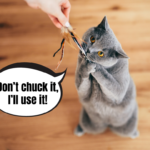The idea of ‘pawternity leave’ will surely appeal to all fabCats who are about to welcome a new furry family member. Whether this is your first kitty or a new addition to your feline clan, the first days in a new home – with new humans and/or new furry companions – can be both exciting and stressful. Don’t let your cat go through this transition alone! This key adaptation period is crucial for building a sense of security, so it’s worth planning it properly. Where should you start? Stick with us till the end, fabCat, and we’ll go through everything together!
A New Home – A New Challenge. What Does Your Cat Need at the Start?
First, it’s important to note that every cat has different needs. Some adapt quickly and seamlessly, while for others, any change in environment is a major source of stress. Cats are territorial animals, so when they are taken away from a familiar environment and placed into the unknown, it takes time for them to adjust.
What does this mean in practice? Hiding under furniture, avoiding contact, running away at sudden movements – these are all common behaviors that, over time, should be replaced by feline curiosity. Once your kitty starts feeling a little safer and more confident, they’ll naturally begin to explore, jump onto shelves, sniff around, and rub against everything in sight. That’s a sign that things are going in the right direction!
So, what does your cat need from you during this time, fabCat? Above all – freedom, space for independent exploration, and your support and presence. That doesn’t mean talking to them constantly, forcing interaction, or pulling them out from under the bed to ‘help them explore.’ As their guardian, your job is to ensure they feel safe and secure while having their needs met. This period is also crucial for building your relationship – if you’re there for your cat in their toughest moments, they’ll surely appreciate it.
Why Should You Take a Few Days of ‘Pawternity Leave’?
Of course, this isn’t an official term you’ll find in labor laws or in most company policies. But among us fabCats, we can call things by their real names – taking a few days off to help your cat adjust to their new home is a fantastic idea. Why?
- You’ll Help Your Cat Acclimate Faster.
The first 24–48 hours are the most crucial after a cat moves to a new home. Whether it’s a young kitten or an adult cat adopted from a shelter, your presence will help them settle in and feel safe. - You’ll Start Building a Bond Right Away.
Cats may be independent, but they also need human companionship. The sooner you start building a relationship, the better! Show yourself as the giver of treats, the best food provider, the diligent litter box cleaner, and the ultimate emotional support system – and you’ll win your new feline’s heart. - You’ll Have Time to Establish a Routine
And as we all know – cats love routines! Regular feeding times, calm play sessions, and quality time together will help your cat understand what their new life will look like. - You’ll Supervise First Interactions.
This is especially important if you already have other cats or pets at home. Introducing them to the new family member takes time and careful supervision. A few days off will allow you to ensure that everything goes smoothly and safely.
How to Make the Most of Your ‘Pawternity Leave’?
If you’ve been following us for a while, fabCat, you probably know what we’re going to say: plan ahead! Cats thrive on routine and order, so if you think things through in advance, the adaptation process will go much more smoothly.
Create a Safe Space. It could be a bedroom, a guest room, or even a walk-in closet – the key is that it should be a quiet, secure place where your cat feels safe. Place a litter box, food and water bowls, a scratching post, a comfy bed, and their carrier in the space. These are essential resources that will help them feel at home.
Don’t Force Interaction. We know it’s tempting, but let your cat decide when they’re ready to leave their hiding spot and make contact. Your presence without pressure will help them feel safer. Don’t pull them out from under the bed, don’t force playtime, and don’t rush to pet them. It’s hard, but it works!
Introduce Simple Rituals. You don’t need to structure every minute of the day, but having set meal times and play sessions will help your cat feel more secure. Even something as simple as waking up and going to bed at the same time every day matters to your feline.
Observe Their Behavior. It’s hard to predict how your cat will react to the change – will they bravely explore, hide in corners, or seek human support? Your time off is perfect for monitoring their needs and behaviors, so you can quickly respond if something requires your attention.
What If You Can’t Take Time Off?
Not everyone has the option to take a few days off when adopting a cat – we get it! But even if you can’t take leave, you can still plan things to make the transition as smooth as possible. What’s worked for us?
Plan the Adoption for a Friday. A long weekend is ideal, but even just Saturday and Sunday will give you 48 hours to fully focus on your cat.
Ask for Help from Family or Friends. Maybe your partner or a family member can spend some time with your cat while you’re at work. Having some company, even for a few hours, can make a big difference in their adaptation.
Limit Your Cat’s Space. If your home is large, start by giving them access to just one safe room. Letting them explore the entire house unsupervised might lead to unexpected trouble.
Make Time for Your Cat After Work. Simply put – when you get home, make up for lost time! Play, interact, and build your bond. It will pay off in the long run!
So, Is ‘Pawternity Leave’ Worth It? If you have the opportunity – absolutely! Taking time off will help your cat feel more comfortable, reduce their stress, and strengthen your bond from day one. Everyone wins. And what about you, fabCats? Did you take time off for your cat’s arrival, or did you manage their adaptation on the go? Let us know in the comments!




